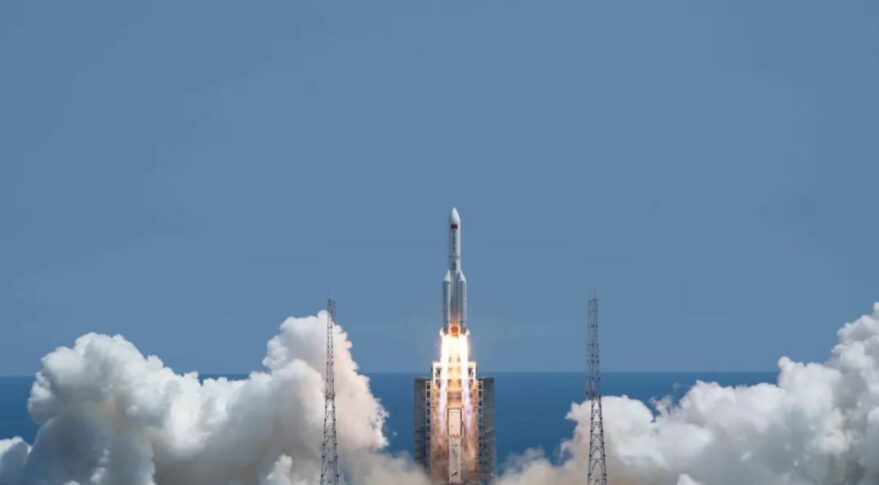
Massive Long March 5B booster predicted to reenter on July 31 (Image Credit: Space News)
HELSINKI — The first stage of the Long March 5B rocket which launched China’s Wentian space station module could reenter the atmosphere around July 31, according to a prediction from the Aerospace Corporation.
China launched the second module for its Tiangong space station early July 24. The Wentian module successfully docked with the already-orbiting Tianhe core module around 13 hours later.
The massive first stage of the rocket—which, exceptionally, also acts as the upper stage for the mission, inserting the payload into its intended orbit—also entered orbit. Initial tracking from U.S. Space Command showed the Wentian module, the Long March 5B booster and another related object from the launch were all in orbit.
Aerospace Corporation experts at the Center for Orbital and Reentry Debris Studies (CORDS) have been closely tracking the 53.6-meter-tall stage, which is thought to have a mass of around 23 metric tons.
They predict a reentry centered on 11:07 UTC (7:07 a.m. Eastern) 31 July, plus or minus 24 hours. The large window for the reentry is due to the challenges of modeling, including variables such as atmospheric fluctuations which affect how quickly the orbit of an object decays. Prediction windows will narrow closer to the reentry event.
Hello #spaceTwitter. We’re tracking the reentry of the CZ-5B rocket body. Our latest prediction is:
🚀 31 Jul 2022 11:07 UTC ± 24 hours
Reentry will be along one of the ground tracks shown here. It’s too early to determine debris footprint. Updates: https://t.co/SxrMtcJnj0 pic.twitter.com/R2QOtdb1zD— The Aerospace Corporation (@AerospaceCorp) July 26, 2022
The most likely scenario is that the stage reenters over the oceans. There is however a “non-zero probability of the surviving debris landing in a populated area—over 88 percent of the world’s population lives under the reentry’s potential debris footprint,” according to an Aerospace Corporation post stated July 26.
“A reentry of this size will not burn up in the Earth’s atmosphere, and the general rule of thumb is that 20–40 percent of the mass of a large object will reach the ground, though it depends on the design of the object,” the post states.
Two previous launches of the Long March 5B resulted in uncontrolled reentries of the rocket’s first stage, in 2020 and 2021.
First stages for orbital launches typically do not reach orbital velocity and fall within a calculated area downrange. Some upper stages, including China’s Long March 2D, restart their engines after delivering a payload into orbit and deorbit themselves to reduce space debris and the risk of collisions in orbit.
However, many upper stages make uncontrolled reentries. Chinese foreign ministry spokesperson Wang Wenbin said last year ahead of the reentry for the booster that launched Tianhe that it was “common practice across the world for upper stages of rockets to burn up while reentering the atmosphere.”
A recent Nature Astronomy paper assesses that current practices mean there is a 10 percent chance of uncontrolled reentries causing one or more casualties over a decade.
Without the ability to restart its engines, the Long March 5B reentry will be uncontrolled. The spent booster will gradually lose altitude due to increasing collisions with molecules in the Earth’s atmosphere, and eventually reenter the atmosphere somewhere between 41 degrees north and 41 degrees south.
The stage’s orbit sees to reach a latitude a little farther north than New York, Madrid, and Beijing, and as far south as southern Chile and Wellington, New Zealand. Ground tracks for individual orbits are shown in an Aerospace Corporation illustration.
China is planning two further Long March 5B launches. The first, scheduled for October, will send a third space station module named Mengtian into orbit. A Hubble-class space telescope, Xuntian, will be launched around 2024 and co-orbit with the completed Tiangong space station.
Earlier on Tuesday China’s human spaceflight agency announced that the Tianzhou-3 cargo spacecraft would make a controlled reentry sometime during July 27 (Beijing time).
Tianzhou-3 launched in September last year to deliver supplies to the Tianhe space station module ahead of the six-month-long Shenzhou-13 crewed mission.
The spacecraft is expected to be commanded to fire its engines to effect a reentry over the South Pacific, as with the earlier Tianzhou missions, and inline with international practice.








